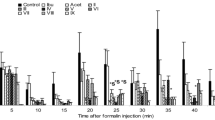p-Aminophenol had been evaluated in the past as an analgesic–antipyretic drug, but its N-acetylated derivative acetaminophen (paracetamol) was found to be the most suitable therapeutically. Acetaminophen is still one of the most popular drugs, which is frequently used for the relief of acute and chronic pain. In this study, new analogs of paracetamol with dimethyl and ethyl substitutions in the phenyl moiety and sulfonamide, which was modified by inserting morpholine, were synthesized (compounds 4 and 5). Then, their conjugated compounds with ibuprofen (6) were synthesized (8 and 9) and the analgesic and anti-inflammatory activities of these new drugs (4, 5, 8, 9) were evaluated in formalin-induced edema test (as a model of acute and chronic chemical pain and also paw edema inflammation) on rats. The results were compared to paracetamol, ibuprofen (as standards), and control (saline) groups. Results showed that the new synthesized derivatives exhibit higher analgesic and anti-inflammatory effects compared to acetaminophen alone for compounds 4, 5, 8 and 9 or ibuprofen for compounds 4, 8 and 9. Moreover, it was concluded that chemical-structural binding of the potent synthesized drugs (4 and 5) with ibuprofen (6) produced new superior anti-nociceptive and anti-inflammatory drugs (8 and 9).



Similar content being viewed by others
References
British Pharmaceutical Codex, 11th ed., Pharmaceutical Press, London (1977), pp. 48 – 54.
P. A. Insel, in: Goodman and Gilman’s The Pharmacological Basis of Therapeutics, J. G Hardman and A. E. Limbird, eds., McGraw Hill, New York (1996), p. 617.
J. L. Wallace and G. Cirino, Trends Pharmacol. Sci., 15 (11), 405 – 406 (1994).
A. Gavals, L. Hadjipetron, and P. Kouronakis, J. Pharm. Pharmacol., 50 (6), 583 – 591 (1998); DOI: 10.1111/j.2042-7158.1998.tb06891.x.
K. D. Rainsford and M. N. Whitehouse, J. Pharm. Pharmacol., 28 (7): 599 – 601 (1976); DOI: 10.1111/j.2042-7158.1976.tb02807.x.
A. S. Kalgutkar, A. B. Marnett,, B. C. Crews, et al., J. Med. Chem, 43(15), 2860 – 2870 (2000): DOI: 10.1021/jm000004e.
M. L. Castro Barbosa, G. M. Albuquerque Melo, Y. K. Cupertino da Silva, et al., Eur. J. Med. Chem., 44, 3612 – 3620 (2009); DOI: 10.1016/j.ejmech.
L. M. Lima and E. J. Barreiro, Curr. Med. Chem., 12, 23 – 49 (2005); DOI: 10.2174/0929867053363540.
T. J. Reilly, J. Chem. Educ., 76(11), 1557 (1999); DOI:10.1021/ed076p1557.
P. L. Chamberlain, Xylazine, FDA, Rockville (1998); http://www.inchem.org/documents/jecfa/jecmono/v38je03.htm.
L. V. Anthony, P. Dennis, K. M. Pranab, et al., Bioorg. Med. Chem., 15, 2206 – 2215 (2007).
D. Dubuisson and S. G. Dennis, Pain, 4 (2), 161 – 174 (1977); DOI: 10.1016/0304-3959(77)90130-0.
M. Gupta, U. K. Mazumder, P. Gomathi, and S. V. Thamil, BMC Complem. Altern. Med. , 6, 36 – 42 (2006); DOI: 10.1186/1472-6882-6-36.
Elliott, R.L.; Ruehle, P.H. Process for the Production of Xylazine, US Patent No. 4 614 798 (Vetamix, Shenandoah, Iowa, 1986).
C. Ming-Fu, Y. Hui-Ming, K. Bor-Wen, et al., Org. Biomol. Chem., 4, 510 – 518 (2006); DOI: 10.1039/B514937A Paper.
R. Y. Mange, M. N. Datta, A. Ananthakrishnan, et al., Bioorg. Med. Chem., 14, 8701 – 8706 (2006).
L. F. Prescott, Drugs, 25 (3), 290 – 314 (1983).
O. Moling, E. Cairon, G. Rimenti, et al., Clin. Therap., 28, 755 – 757 (2006); DOI:10.1016/j.clinthera.2006.05.002.
P. Y. Johnson, R. Pan, J. Quan Wen, and C. J. Halfman, J. Org. Chem., 46, 2049 – 2054 (1981); DOI: 10.1021/jo00323a014.
S. Alshahrani, F. Fernandez-Conti, A. Araujo, and M. DiFulvio, J. Visual. Exp., 17(63), 3785 – 3791 (2012); DOI: 10.3791/3785.
J. Muñoz, C. Navarro, V. Noriega, et al., Inflammopharmacology, 18(2): 65 – 71 (2010); DOI: 10.1007/s10787-009-0019-7.
R. M. Rezende,; D. S. Franca, G. B. Menezes, et al., Brit. J. Pharmacol., 153(4), 760 – 768 (2008); DOI: 10.1038/sj.bjp.0707630.
S. S. Ayoub, G. Pryce, M. P. Seed, et al. Drug Metab. Dispos., 39(9), 1689 – 1695 (2011); DOI: 10.1124/dmd.111.038638.
D. A. Andersson, C. Gentry, L. Alenmyr, et al., Nature Commun., 2(551), 1038 – 1059 (2011); DOI: 10.1038/ncomms1559.
Acknowledgements
This work was a research project at the Islamic Azad University, Karaj Branch, Iran, and benefited from the financial support of INFS (Iran National Foundation Support). The authors would like to express their gratitude to both sponsors. They thank Fariba Ansari for her assistance in the pharmacological tests. They appreciate Dr. Natasha Pourdana, certified editor in the Journal of Language Education in Asia (LEiA), for proofreading the initial draft of this article.
Author information
Authors and Affiliations
Corresponding author
Additional information
Conflict of Interest
This research is not a part of our normal lecturing, employment, consultation and involvement. No institution will require any rights from this work too. In addition, no patent has been applied. No commercial right has been given to any company and/or institution, or it will not be done later either.
Rights and permissions
About this article
Cite this article
Ahmadi, A., Khalili, M., Ahmadian, S. et al. Synthesis and Pharmacological Evaluation of New Chemical Entities Based on Paracetamol and Their Ibuprofen Conjugates as Novel and Superior Analgesic and Anti-Inflammatory Candidates. Pharm Chem J 48, 109–115 (2014). https://doi.org/10.1007/s11094-014-1059-x
Received:
Published:
Issue Date:
DOI: https://doi.org/10.1007/s11094-014-1059-x




